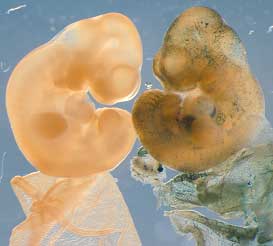| RIKEN Center for Developmental Biology (CDB) 2-2-3 Minatojima minamimachi, Chuo-ku, Kobe 650-0047, Japan |
The group used a conditional genetic technique that allowed them to label yolk sac-derived blood precursors in a spatially and temporally specific manner. “I think the fact that we were able to study this process non-invasively and over the long term was critical,” says Samokhvalov. “Anytime you take tissue out of its normal context, you introduce stresses on the system that can affect how it behaves, which can give you an inaccurate picture of what is really gong on in the embryo.” The yolk sac-derived cells were found to contribute to both the erythroid (red blood) and lymphoid (white blood) lineages in embryos, but interestingly, their contribution to the formation of the yolk sac blood vessels was negligible. This stands counter some long-held claims for the existence of what has come to be known as the “hemangioblast,” the presumed mutual origin of both the blood and the vascular system. The Nishikawa group instead found that, while the Runx1+ yolk sac precursors play a part in definitive hematopoiesis, their contribution to blood vessel development is small to none. “The picture that is developing from the cell tracing at different developmental time points is one of cells migrating from the extraembryonic region to the embryo proper,” says Samokhvalov. “It may be that by E9.5 all commitments are made, with cells destined to become long-term stem cells associating with the endothelia of the embryonic vasculature, while those engaged in generating red blood cells for the embryo get recruited to the fetal liver where they begin proliferating. But by that point, the Runx1-positive cells are certainly already specified to the blood lineage.” The persistence of the cell tagging system used in this study even enabled the group to study the contribution of yolk sac precursors to adult hematopoiesis. Using flow cytometry to identify blood progenitors derived from the yolk sac, the group found a contribution of up to 10% of the adult. “We can’t yet say quantitatively how much of a role the yolk sac precursors play in definitive hematopoiesis, only that they do,” cautions Samokhvalov. “We still don’t know how large a fraction of the Runx1+ cells is labeled by our method, so it’s possible that the true contribution is even higher than what we were able to find.”
|
|||||
|
|||||
 |
| Copyright (C) CENTER FOR DEVELOPMENTAL BIOLOGY All rights reserved. |
